The previous post in the BPOS series, covered the steps to set up an Exchange Online environment for testing. I covered the installation of the Single Sign In client software, setting up Exchange users, mailboxes, resources, contacts and sent some email and meeting invitations.
This post will focus on the complimentary communications services: Web Conferencing (Live Meeting) and Office Communicator. Web Conferencing is built in to Exchange, so I’ll cover that first. Communicator, takes a bit longer to explain.
Web Conferencing (Live Meeting)
Live Meeting is automatically installed as it relies on Outlook for some of its functionality like scheduling a meeting by adding users and resources and sending out the meeting invitation via an email. Wizards guide you through the process. The organizer is the presenter and the role is fixed as this is a one-way presentation media. Roles can’t be transferred. The presentation can be recorded and saved for on-demand presentation.
You can launch Web Conferencing from the Sign In application.
You’ll be taken to the Live meeting Web Site where you can schedule, join a meeting or create a meeting immediately.
Communicator
Instant Messaging, also known as Office Communicator is a service that has to be enabled for use in the Administration Portal. Office Communicator 2007 allows you to exchange instant messages, make phone and video calls, and see the availability of contacts in your network.
Enable the service
According to the documentation, Office Communicator Online cannot work with your on-premise version or with any other instant messaging programs like Yahoo or AOL. Online Communicator does not use the Outlook model of having an online profile and an on-premise profile. This means that users in your company who have configured Office Communicator to work online cannot communicate with others who are using on-premise Communicator or with any other IM client.
Because of this, the administrator needs to manually enable Online Communicator through the Administration Center. Until you enable the service, the Online Services Sign In application will not automatically configure Communicator to work with Online Services. After it’s enabled, the Sign In application will automatically configure each of the licensed users to use the Online Communicator and at that point the user will no longer be able to connect with the on-premise users.
Download and install the client
The Communicator client (OCClient) is a separate application that is not part of the Single Sign In application. At each workstation, navigate to Microsoft Online Services Office Communicator Client Download page.
Accept the terms & conditions. Click download. I prefer to run the installation directly as there is no point in saving the setup stub which will only run once to start the installation from the download site. The Office Communicator 2007 R2 setup runs. Click Next, accept the license terms and the default settings. The setup program automatically configures Communicator to work with Online Services and the Windows firewall.
The next part is confusing as the Communicator Sign In window
appears and also a “Welcome to Communicator” web page launches as a “pop up” offering you a tour of the product. This in itself is useful for users not familiar with Communicator; however, it tends to interrupt the setup process. I suggest you close the window and use the Help feature when you have questions.
Clicking the Sign In button on the Communicator Sign In window will produce an error. If you are logged in through the Sign In application, logout and exit the program. Close the Communicator Sign In program as well. Launch the Online Services Sign In program and you will see the Microsoft Office Communicator application has been added to the Home tab.
Remember that the Communicator Sign In program is distinct from the Online Sign In program. This is by design as was previously mentioned since the on-premise and online services are incompatible. So, if you are using Communicator online as I am in the trial, you will need to use the Online Sign In program to configure Communicator before it will allow you to logon successfully.
Sign in
After signing in, you can alter your status, select other users to initiate a conversation, save the contacts in your own list, and once a conversation is established, you can invite others to join the conversation. I won’t go into all the details of communicator here, If you have the hardware to support it, you get video and audio as well as desktop and program sharing. It’s kind of like having a mini- Live Meeting, Skype kind of thing.
If you’re prompted for sign credentials, the Active Directory domain login is in the following form: RED001\<user>_elap.microsoftonline.com, in this case, RED001\john_elap.microsoftonline.com.
So that’s it for the other communications features. Next, I explore SharePoint. Stay tuned …
This posting is provided “as is” with no warranties, guaranties or any rights whatsoever. All content is based on the author’s experiences and opinions and is not intended to influence the actions of the reader.
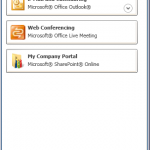
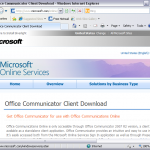
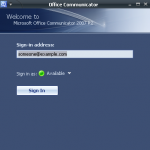
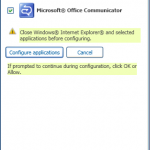
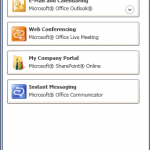

Pingback: BPOS for ELAP … results | Level 7 TechnoBlog
Pingback: BPOS for ELAP … the results | Level 7 TechnoBlog
Pingback: BPOS for ELAP … the conclusion | Level 7 TechnoBlog
Pingback: BPOS for ELAP … SharePoint | Level 7 TechnoBlog